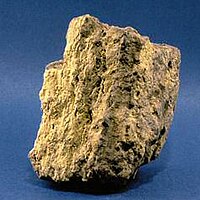
Photo from wikipedia
Abstract The unique Aldan ore-magmatic province in Yakutia is characterized by Mesozoic alkaline magmatism and related ore deposits (Cu-Au porphyry, gold-quartz vein and gold-brannerite). The Murunskiy alkaline massif occurs in… Click to show full abstract
Abstract The unique Aldan ore-magmatic province in Yakutia is characterized by Mesozoic alkaline magmatism and related ore deposits (Cu-Au porphyry, gold-quartz vein and gold-brannerite). The Murunskiy alkaline massif occurs in the western part of this province. This massif includes the world's largest volcanic-plutonic complex of potassium-alkaline rocks and has no analogs in the world. High agpaitic indexes are common for all magmatic rocks of the massif. Moreover, the massif is well known for its unique Ba-Sr carbonatite and charoite rocks. We have studied the fluid regime of a post-magmatic formation of rutile and anatase-brookite quartz veins with pyrite, galena, sphalerite, chalcopyrite, native gold and the titanium mineralization. Fluid inclusions study shows that the titanium mineralization was formed at the temperature range of 475–440 °C and pressure between 150 and 125 MPa from heterogeneous chloride-carbonate-sulfate fluid. The immiscible fluid fractions were represented by gaseous phase, low- and middle-concentrated solutions, as well as highly concentrated salt brine. Mineral-forming fluids were characterized by high redox-potential, due to the high concentration of sulfates. The immiscible fluid fractions differ in the content of ore elements. Highly concentrated fluid fractions contain increased concentrations of S, Cu, Mo, Fe, Pb, Zn, U, and Au, and low-concentrated fluid fractions containing U, Th, As, and Au.
Journal Title: Ore Geology Reviews
Year Published: 2017
Link to full text (if available)
Share on Social Media: Sign Up to like & get
recommendations!